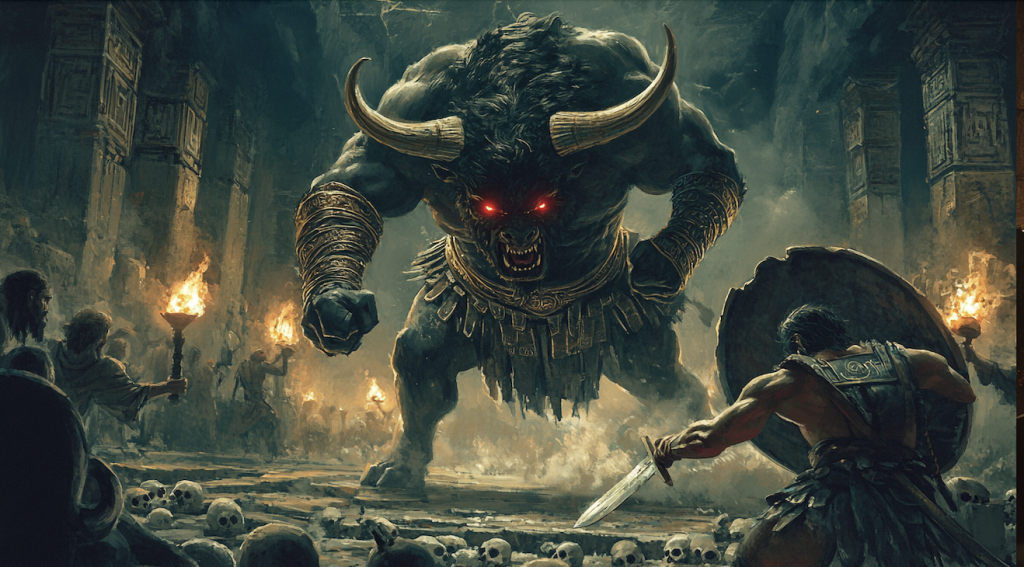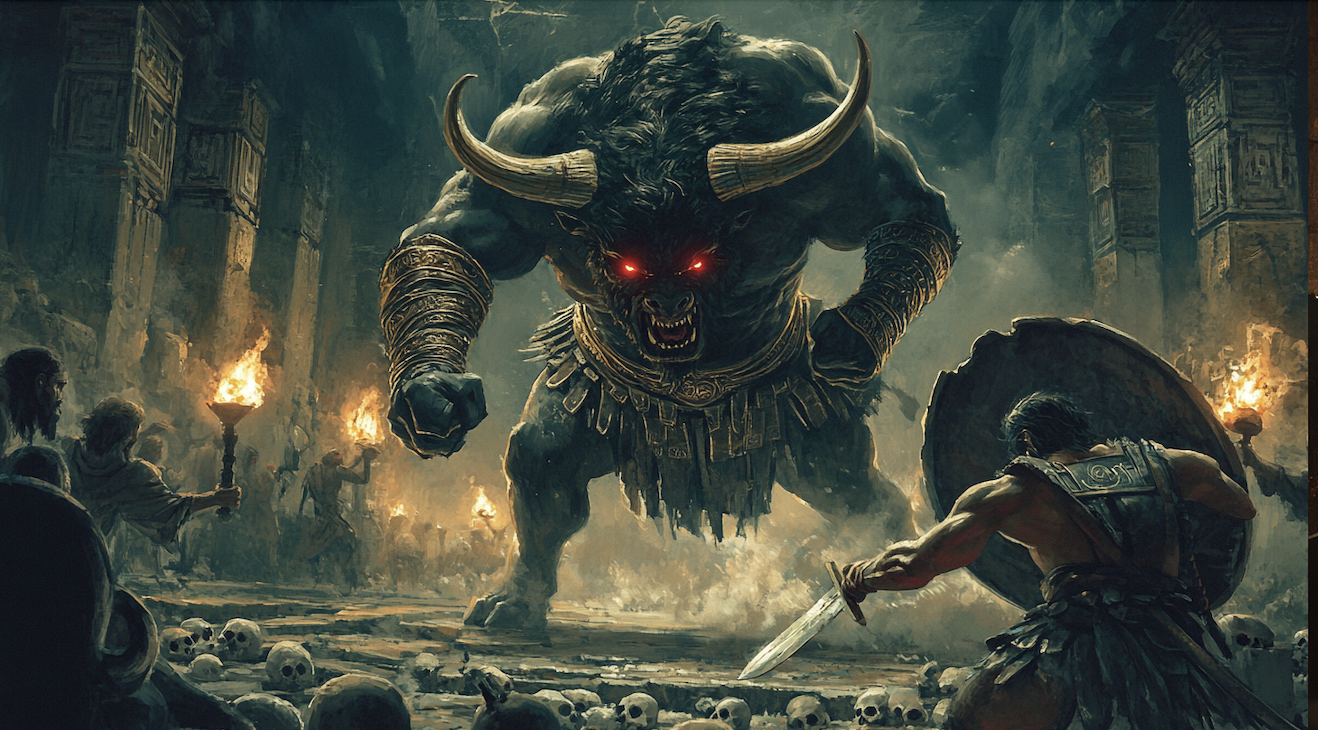
The Labyrinth of Knossos is one of the most famous locations in Greek mythology, known for being the home of the fearsome Minotaur, a half-man, half-bull creature. This massive and intricate maze was constructed by the legendary craftsman Daedalus on the island of Crete, at the command of King Minos. The myth of the Labyrinth is a tale of betrayal, sacrifice, and heroism, centering on the heroic Theseus and his quest to slay the Minotaur and end the cruel practice of human sacrifices.
The Labyrinth has captivated the imaginations of people for centuries, symbolizing complex challenges, the idea of entrapment, and the possibility of escape through intelligence and bravery.
The Origins of the Labyrinth
The story of the Labyrinth begins with King Minos, the ruler of Crete. According to legend, Minos prayed to the god Poseidon for a sign that he was the rightful king of Crete. Poseidon sent Minos a magnificent white bull from the sea, with the understanding that Minos would sacrifice the bull in honor of the god. However, Minos was so impressed by the beauty of the bull that he decided to keep it for himself and sacrifice a lesser animal in its place.
Angered by Minos’s disobedience, Poseidon cursed Minos’s wife, Pasiphae, with an unnatural desire for the bull. Under the influence of the curse, Pasiphae sought the help of Daedalus, the famous architect and inventor, to fulfill her desire. Daedalus constructed a wooden cow for Pasiphae to hide inside, allowing her to mate with the bull. The result of this union was the Minotaur, a monstrous creature with the body of a man and the head of a bull.
The Construction of the Labyrinth
Horrified by the creature’s existence but unable to kill it, King Minos ordered Daedalus to build a massive and inescapable Labyrinth to imprison the Minotaur. The Labyrinth was an enormous, complex maze beneath the palace at Knossos, designed so that anyone who entered it would become hopelessly lost, never finding their way out.
Minos kept the Minotaur in the heart of the Labyrinth, feeding it a diet of human flesh. To satisfy the monster’s hunger, Minos demanded a terrible tribute from Athens—every nine years, the city was required to send seven young men and seven young women to Crete, where they would be sent into the Labyrinth to be devoured by the Minotaur. This tribute was a punishment for the death of Minos’s son, Androgeus, who had been killed in Athens.
Theseus and the Minotaur
The hero Theseus, prince of Athens, could not stand to see his people suffer under this cruel tribute. Determined to end the slaughter, Theseus volunteered to be one of the tributes sent to Crete, with the intention of entering the Labyrinth and killing the Minotaur.
When Theseus arrived in Crete, he caught the attention of Ariadne, the daughter of King Minos. Ariadne fell in love with Theseus and, unwilling to see him perish in the Labyrinth, decided to help him. She sought out Daedalus, who had designed the Labyrinth, and he provided her with a clever solution—a ball of thread. Ariadne gave Theseus the thread and instructed him to unravel it as he ventured into the maze, so he could follow it back to the entrance after killing the Minotaur.
The Slaying of the Minotaur
With Ariadne’s help, Theseus entered the Labyrinth, carefully unspooling the thread behind him as he navigated the twists and turns of the maze. Deep within the Labyrinth, Theseus encountered the Minotaur. Using his strength and courage, Theseus fought the beast and, after a fierce struggle, killed the Minotaur with his sword.
With the Minotaur dead, Theseus followed the thread back through the Labyrinth, retracing his steps to find the exit. He escaped the maze, bringing an end to the gruesome sacrifices demanded by King Minos.
The Escape from Crete
After defeating the Minotaur, Theseus and Ariadne fled Crete together. However, their journey was not without complications. On their way back to Athens, they stopped at the island of Naxos, where Theseus, for reasons that vary across different versions of the myth, abandoned Ariadne. In some accounts, he left her because the gods commanded it, while in others, it was due to his own selfishness.
Ariadne was later rescued by the god Dionysus, who made her his wife, granting her immortality. Meanwhile, Theseus returned to Athens as a hero, having freed his city from the dreadful tribute to the Minotaur.
The Symbolism of the Labyrinth
The myth of the Labyrinth and the Minotaur holds deep symbolic meaning in Greek mythology. The Labyrinth itself represents a complex and confusing challenge—a place where one can easily become lost, both physically and metaphorically. It is a symbol of entrapment, confusion, and the struggle to find one’s way out of difficult situations.
The Minotaur, half-man and half-beast, symbolizes the darker side of human nature—savagery, violence, and the uncontrolled forces that can lurk within individuals. Theseus, by defeating the Minotaur, represents the triumph of civilization over chaos, reason over barbarism, and intelligence over brute force.
The ball of thread, given by Ariadne, symbolizes guidance, wisdom, and the help that others can provide in navigating life’s challenges. It is a reminder that even the most difficult problems can be solved with the right tools and support.
The Legacy of the Labyrinth of Knossos
The Labyrinth of Knossos has left a lasting legacy in both mythology and archaeology. The ancient city of Knossos, located on the island of Crete, is believed to have been the inspiration for the myth, and its ruins can still be visited today. The labyrinthine layout of the palace complex, with its many rooms and corridors, may have contributed to the idea of the Labyrinth.
In literature and art, the myth of the Labyrinth and the Minotaur has been retold and reinterpreted countless times, symbolizing humanity’s ongoing struggle with internal and external challenges. It remains one of the most enduring myths of Greek mythology, a story of bravery, love, and the quest for freedom.
Through the tale of Theseus, Ariadne, and the Minotaur, the Labyrinth of Knossos continues to inspire, reminding us of the power of intelligence, courage, and perseverance in the face of overwhelming odds.





